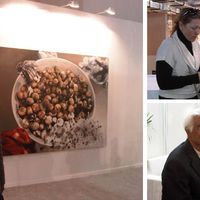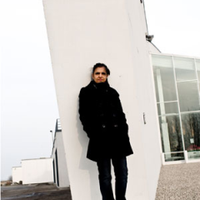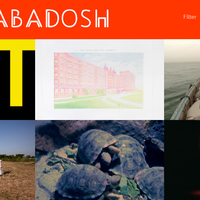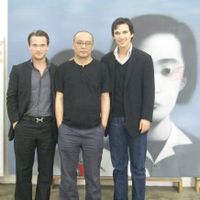Beyond an Art Fair – part 2
 culture360.org contributor, Bharti Lalwani, was in New Delhi last month to attend the third edition of the India Art Summit. In this second part of her article, she explores the private initiatives that where presented along the main programme of the Fair.
culture360.org contributor, Bharti Lalwani, was in New Delhi last month to attend the third edition of the India Art Summit. In this second part of her article, she explores the private initiatives that where presented along the main programme of the Fair.“It’s an interesting moment...a coming together of people from several parts of India and the world, all here together in this city at one time and this doesn’t always happen. It’s a collective energy which is fantastic...What’s interesting is the fact that you have an exciting space for dialogue at the Summit but you also have all over Delhi an interesting network of exhibitions and events which keeps the art in the city alive!”- Jitish Kallat (Artist)
[caption id="attachment_7806" align="alignright" width="300" caption="Exterior shot of IAS"]
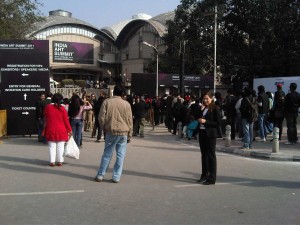 [/caption]
[/caption]Apart from the intense Summit forums, the KHOJ Marathon, a series of ten minute interviews conducted by Hans Ulrich with 25 leading intellectuals, thinkers, social philosophers, economists, architects and artists, complimented the Art Fair as one of the satellite events in the city. Chiefly supported by the British Council, Swiss Arts Council, Coimbatore Centre for Contemporary Arts (CoCCA) and the Goethe Institute, and held between 2 to 10 pm on the 22nd of January, the interview marathon is the first of its kind in India. The spirited event, set in the historic Lodi Gardens, drew a tremendous audience mainly from the art fraternity itself. However as if to demonstrate a point, as the evening progressed with Physicist/ Philosopher Sundar Sarukkai discussing the “Indian temperament”, the event was ironically “hijacked” by blaring Bollywood music from the garden behind the venue which was hosting an opulent Indian Wedding reception! As for the two main private initiatives launched in collaboration with the summit, the first was the launch of the Kiran Nadar Museum of Art. Kiran and Shiv Nadar, founders of the $5 billion technology company HCL, have been collecting art since the last three decades.
“Art should not be the purview of just the rich.” Said Kiran Nadar in her opening statement; as their diverse collection grew, they decided to share it in a public space rather than keeping a repository of sorts. KNMA intends to exemplify the dynamic relationship between art and culture through its exhibitions, publications, educational and public programs.
“We are developing art education initiatives especially for children and we are also planning an expansion of the museum (funded by the Shiv Nadar Foundation) which will then have the space to host international exhibitions and specially curated shows spawned from collaborations with museums worldwide.” - Roobina Karode, Director and Chief Curator of KNMA
The second private initiative was the Skoda Prize for contemporary artists; self proclaimed as the most prestigious award on the Indian Visual Arts scene. Personally, any association with Skoda would be tantamount to social suicide but it seemed that artist Anish Kapoor, dressed in a shiny metallic suit not unlike his reflective sculptures, did not mind as he was Guest of Honour and the presenter of the award to the winner, artist Mithu Sen (whose work dealt with sexuality, gender and taboo). Thomas Kuehl, Board member and Director of Skoda Auto declared his ambition for the initiative to be on par with the Turner Prize and the Indian Minister of Culture in a spontaneous (read unprepared) speech stated with gusto that with all these private initiatives such as the Indian Art Summit, the new private museum (whose name he failed to recollect until prompted, despite Kiran Nadar standing right behind him) and now the Skoda prize, he hoped that the role of the government will be less and less! This statement was hardly met with any applause and a very senior Indian artist sitting next to me heckled “Shame! Shame!”
[caption id="attachment_7807" align="alignright" width="300" caption="Subodh Gupta @ Sculpture Park"]
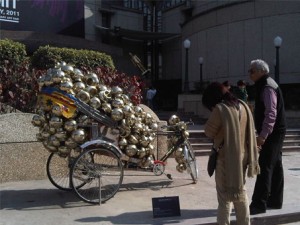 [/caption]
[/caption]Perhaps the minister should have paused to think of the repercussions of such a remark: what did that mean for India’s cultural policy? What did it mean in terms of funding for the public museums which are already in a dire state? Where other countries’ governments are actively putting their weight behind art and culture (France, UK, Singapore) does India’s bureaucracy get in the way of sustaining museums? And if that is the case, should Indian public museums be privatized? What about the fate of govt. funded art academies, institutes and universities?
The KNMA, ofcourse, is not the first private museum to open in India, mother-son collector duo Lekha and Anupam Poddar launched the Devi Art Foundation in 2008 in Gurgaon, an extension of Delhi. In Mumbai, Neville Tuli will soon be launching his own museum “Osianama”; Kolkata Museum of Modern Art (KMoMA) is scheduled to open in 2013; veteran collector Rajshree Pathy is in the process of creating her own world class museum and educational institute called Coimbatore College of Contemporary Art (CCoCA) which supported the Khoj interview marathon.
[caption id="attachment_7808" align="alignright" width="300" caption="H.S Raza being interviewed at the fair"]
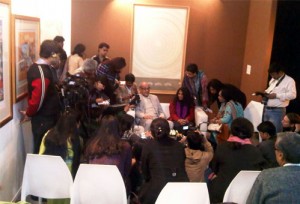 [/caption]
[/caption]To quickly summarize, the heady experience of the phenomena that has been the India Art Summit- a condensed biennale event, has left me, a categorized NRI (an outsider looking in), with many questions and wonderings about India, its passive government and aggressive private individuals armed with an influx of wealth, who are significant players in the art world and are calling for a paradigm shift. These are indeed interesting times ahead for the Indian art scene. As for the Fair itself, Neha Kirpal finds her optimism affirmed-
"In the years ahead as India becomes a greatly sought after art market for international art, I see the art fair becoming the most important gateway for showing international art to Indian audiences. It will encourage collecting on a whole other level, truly international and to each his own!"
References:
khojworkshop.org
www.indiaartsummit.com
www.deviartfoundation.org
www.knma.in
Bharti Lalwani has an MA in Contemporary Art and writes for publications such as Asian Art News and www.arterimalaysia.com, curates on occasion and is currently developing art education approaches for children under 10 years of age.
Similar content
15 Feb 2011
posted on
12 Apr 2010
posted on
25 May 2016
20 May 2011
17 May 2011

